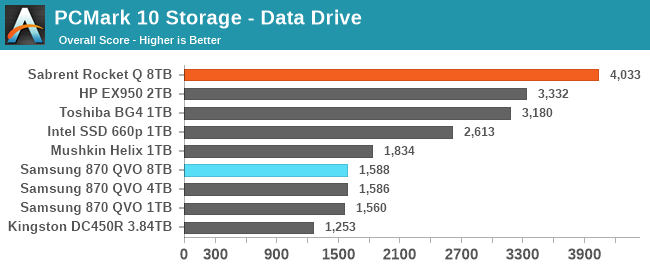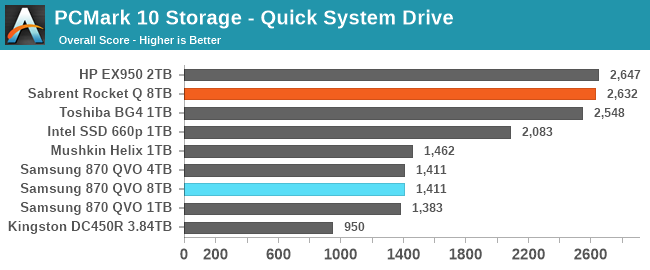QLC Goes To 8TB: Samsung 870 QVO and Sabrent Rocket Q 8TB SSDs Reviewed
by Billy Tallis on December 4, 2020 8:00 AM ESTPCMark 10 Storage Benchmarks
At the end of 2019, UL released a major update to their popular PCMark 10 benchmark suite, adding storage performance tests that had been conspicuously absent for over two years. These new storage benchmarks are similar to our AnandTech Storage Bench (ATSB) tests in that they are composed of traces of real-world IO patterns that are replayed onto the drive under test. We're incorporating these into our new SSD test suite, and including our first batch of results here.
PCMark 10 provides four different storage benchmarks. The Full System Drive, Quick System Drive and Data Drive benchmarks cover similar territory to our ATSB Heavy and Light tests, and all three together take about as long to run as the ATSB Heavy and Light tests combined. The Drive Performance Consistency Test is clearly meant to one-up The Destroyer and also measure the worst-case performance of a drive that is completely full. Due to time constraints, we are not yet attempting to add the Drive Performance Consistency Test to our usual test suite.
| PCMark 10 Storage Tests | ||
| Test Name | Data Written | |
| Data Drive | 15 GB | |
| Quick System Drive | 23 GB | |
| Full System Drive | 204 GB | |
| Drive Performance Consistency | 23 TB + 3x drive capacity | |
The primary subscores for the PCMark 10 Storage benchmarks are average bandwidth and average latency for read and write IOs. These are combined into an overall score by computing the geometric mean of the bandwidth score and the reciprocal of the latency score. PCMark 10 also records more detailed statistics, but we'll dig into those in a later review. These PCMark 10 Storage test runs were conducted on our Coffee Lake testbed:
| AnandTech Coffee Lake SSD Testbed | |
| CPU | Intel Core i7-8700K |
| Motherboard | Gigabyte Aorus H370 Gaming 3 WiFi |
| Chipset | Intel H370 |
| Memory | 2x 8GB Kingston DDR4-2666 |
| Case | In Win C583 |
| Power Supply | Cooler Master G550M |
| OS | Windows 10 64-bit, version 2004 |
Data Drive Benchmark
The Data Drive Benchmark is intended to represent usage a secondary or portable drive may be subject to. This test simulates copying around files, but does not simulate the IO associated with launching and running applications from a drive.
 |
|||||||||
| Overall Score | Average Bandwidth | Average Latency | |||||||
Starting off, the 8TB Sabrent Rocket Q leads the field thanks to its massive and fast SLC cache; it clearly outperforms even the decently high-end 2TB TLC-based HP EX920. The several capacities of the Samsung 870 QVO all performa about the same: less than half the speed of the faster NVMe drives, and slower than the slowest entry-level NVMe drives. The enterprise SATA drive with no SLC caching comes in last place.
Quick System Drive Benchmark
The Quick System Drive Benchmark is a subset of the Full System Drive Benchmark, running only 6 out of the 23 sub-tests from the Full test.
 |
|||||||||
| Overall Score | Average Bandwidth | Average Latency | |||||||
Moving on to the Quick test, the Sabrent Rocket Q no longer stands out ahead of the other NVMe drives, but still offers decent performance. The performance gap between the NVMe drives and the Samsung 870 QVO drives has narrowed slightly, but is still almost a factor of two.
Full System Drive Benchmark
The Full System Drive Benchmark covers a broad range of everyday tasks: booting Windows and starting applications and games, using Office and Adobe applications, and file management. The "Full" in the name does not mean that each drive is filled or that the entire capacity of the drive is tested. Rather, it only indicates that all of the PCMark 10 Storage sub-tests are included in this test.
 |
|||||||||
| Overall Score | Average Bandwidth | Average Latency | |||||||
The Full test starts to bring the downsides of QLC NAND into focus. The Sabrent Rocket Q is now the slowest of the NVMe drives, only moderately faster than the 8TB Samsung 870 QVO. The 1TB 870 QVO is also falling behind the larger and faster models. However, the QLC-based Intel 660p manages to hold on to decent performance, possibly a result of the class-leading SLC cache performance we usually see from Silicon Motion NVMe controllers paired with Intel/Micron flash.










150 Comments
View All Comments
Kevin G - Friday, December 4, 2020 - link
At 1 Gbit easily sure, but 2.5 Gbit is taking off in the consumer space and 10 Gbit has been here for awhile but at a price premium. There is also NIC bonding which can increase throughput further if the NAS has multiple active users.TheinsanegamerN - Saturday, December 5, 2020 - link
A single seagate ironwolf can push over 200MB/s read speeds. 2.5 Gbit will still bottleneck even the most basic raid 5 arrays.heffeque - Friday, December 4, 2020 - link
I want a silent NAS.Also SSD last longer than HDD.
I'm hoping for a Synology DS620Slim but with AMD Zen inside (like the DS1621+), and I'll fill it up with 4TB QVO drives on SHD1 with BTRFS.
david87600 - Friday, December 4, 2020 - link
Re: SSD lasts longer than HDD:Not necessarily. Especially with high volumes of writes. We've had more problems with our SSDs dying than our HDDs. We have several servers but the main application runs on an HDD. We replace our servers every four years but the old servers go into use as backup servers or as client machines. Some of those have been running their HDDs for 15 years now. None of our SSDs have lasted more than 2 years under load.
heffeque - Saturday, December 5, 2020 - link
The Synology DS620Slim is not even near an enterprise server. Trust me, the SSDs won't die from high volume writes on a home user.TheinsanegamerN - Saturday, December 5, 2020 - link
Completely different use case. Home users fall under more of the WORM style of usage, they are not writing large data sets constantly.I also have no clue what you are doing to your poor SSDs. We have our SQL databases serving thousands of users reading and writing daily on SSDs for 3 years now without a single failure. Of course we have enterprise SSDs instead of consumer, so that makes a huge difference.
Deicidium369 - Saturday, December 5, 2020 - link
I have far more dead HDDs than dead SSDs. The 1st SSD I bought was an OCZ midrange, 120GB - that drives has been used continuously for several years - about a year ago, wiped it and checked it - only a few worn cells. On the other hand - I had had terrible luck with anything over 8TB mechanical - out of the close to 300 14TB Seagates - over 10% failure rate - about half of those died during the 48 hour burn in - and the rest soon after.The Intel Optane U.2 we used in the Flash array have had no issues at all over the 3 year period - we had one that developed a power connector failure - but no issues with the actual media.
as with most things tech YMMV
GeoffreyA - Sunday, December 6, 2020 - link
Just a question. Between Seagate and WD, who would you say is worse when it comes to failures? Or are they about the same?Deicidium369 - Sunday, December 6, 2020 - link
I have not used WD in some time - so I can't comment I tend to use Backblaze failure rates - https://www.backblaze.com/blog/backblaze-hard-driv...GeoffreyA - Monday, December 7, 2020 - link
Thanks